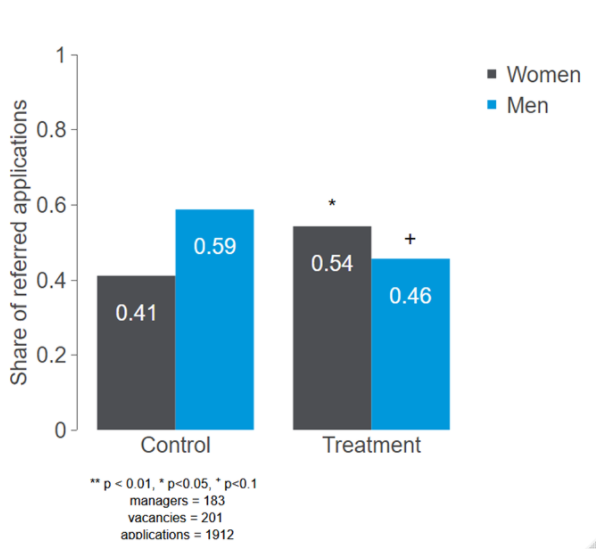Occupational segregation is one of the key factors driving the gender pay gap in the UK. Women make up the majority of workers in lower paying occupations and the minority in higher paying ones.
One of the barriers for women to enter higher paying occupations is that they have smaller networks in these fields, which reduces the likelihood of being referred for a job. Personal recommendations are one of the key hiring channels, but this can limit diversity if employees only refer people who are similar to them.
Analysing MOD’s data to understand the source of their gender pay gap
We partnered with the Ministry of Defence (MOD) to find ways to reduce their gender pay gap. We analysed their HR data on recruitment and retention, pay and bonuses, progression and performance, sick leave and parental leave and more. In addition to examining ‘raw’ data, we compared similar employees by accounting for a number of factors (e.g. grade, tenure, job type, region, and working pattern) that might otherwise vary between men and women.
We found that in most grades, women made up less than 40% of applicants, and the share of women applying was lower than the share of women currently working in those grades at MOD. Even though women were less likely than men to apply, they were more likely to be hired when they did. This highlighted that increasing applications from women was key to improving MOD’s gender pay gap.
Testing the impact of targeted referrals on applications from women at MOD
We designed an intervention to diversify the range of people employees organically share new vacancies with by explicitly encouraging staff to share vacancies with underrepresented groups: targeted referrals. We also encouraged managers to participate with a friendly competition between departments. Like many organisations, MOD does not have a formal incentivised referrals scheme, so findings from this trial could apply to a wide range of male-dominated companies.

Download the report
To test the impact of targeted referrals we ran a two-armed randomised controlled trial (RCT). As hiring managers advertised new vacancies in areas of MOD where women had been historically underrepresented, they were randomly allocated to either the control group or the intervention group.
Managers in the intervention group received an email inviting them to challenge their team to share the role with five women. Managers in the control group did not receive this communication. We ran the trial for five months with around 800 hiring managers, 1000 vacancies, and over 18,000 applications.
Targeted referrals rebalanced the gender make-up of referrals
While referrals in the control group reflected the gender make-up of the organisation (41% women), targeted referrals improved the gender balance among referrals (54% women) – an increase of 13 percentage points. Twice as many women were referred to a vacancy in the intervention group.

Targeted referrals increased both the number of applications from women and the number of offers made to women. However, they also resulted in more men applying and receiving offers. As a result, the intervention did not lead to significant changes in the share of applications from women and the share of offers made to women.
We checked to make sure there were no unintentional negative effects for other minority applicants, in terms of ethnicity, sexuality and disability, and did not find any. Finally, targeted referrals had a positive impact on the quality of applicants as vacancies in the intervention group were significantly more likely to find a suitable candidate compared to the control group.
Recommendations for employers
Our results suggest that targeted referrals can rebalance the existing gender inequality in informal referrals. We recommend that organisations understand whether attracting or selecting applicants is the source of inequality in recruitment before considering targeted referrals, and that employers test and evaluate targeted referrals with a wider range of underrepresented groups.





